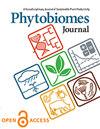The Effect of Septoria glycines and Fungicide Application on the Soybean Phyllosphere Mycobiome
IF 2.6
3区 生物学
Q2 MICROBIOLOGY
引用次数: 1
Abstract
Septoria brown spot, caused by Septoria glycines, is Illinois’ most prevalent soybean disease. It is common to use foliar fungicides to control Septoria brown spot and other late-season diseases of soybean. The effects of fungicide on nontarget organisms in the phyllosphere are unknown. To study the effect of S. glycines and fungicide application on the soybean phyllosphere mycobiome, we conducted a replicated field trial and collected samples at three soybean developmental stages. Then, we sequenced full-length internal transcribed spacer and a partial large subunit region using Oxford Nanopore technologies. Sequencing and data analysis produced 3,342 operational taxonomic units. The richness of the fungal community increased with the host development. There were differences in mycobiome diversity between soybean lines at the early developmental stage but not at the reproductive stages. Inoculation with S. glycines did not affect the α diversity but some significant changes were observed for the β diversity. At the beginning seed stage (R5), fungicide application changed the composition of the fungal community. The fungicide treatment decreased the proportion of several fungal taxa but it increased the proportion of Septoria. The core mycobiome in the phyllosphere was composed of genera Gibberella, Alternaria, Didymella, Cladosporium, Plectosphaerella, Colletotrichum, and Bipolaris. Network analysis identified significant interactions between Septoria and Diaporthe, Bipolaris, and two other taxonomic units. In this study, we set Septoria as the target organism and demonstrated that metabarcoding could be a tool to quantify the effect of multiple treatments on the mycobiome community. Better understanding of the dynamics of the phyllosphere microbiome is necessary to untangle the late-season diseases of soybean.甘氨酸和杀菌剂对大豆叶层菌群的影响
稻瘟病是由稻瘟病甘氨酸引起的,是伊利诺伊州最普遍的大豆病害。常用叶面杀菌剂防治黄斑病等大豆晚季病害。杀菌剂对层层中非目标生物的影响尚不清楚。为了研究甘氨酸葡萄球菌和杀菌剂对大豆叶层真菌群落的影响,我们在大豆发育的三个阶段进行了重复田间试验和样品采集。然后,我们使用Oxford Nanopore技术对全长内部转录间隔区和部分大亚基区域进行测序。测序和数据分析产生了3342个可操作的分类单位。真菌群落的丰富度随着寄主的发育而增加。大豆系间真菌群落多样性在发育早期存在差异,而在生殖期无差异。接种甘氨酸对α多样性无显著影响,但对β多样性有显著影响。在种子初期(R5),施用杀菌剂改变了真菌群落的组成。杀菌剂处理降低了几个真菌类群的比例,但增加了Septoria的比例。层球核心菌群由赤霉素属、Alternaria属、Didymella属、枝孢菌属、Plectosphaerella属、炭疽菌属和Bipolaris属组成。网络分析发现Septoria与Diaporthe、Bipolaris和其他两个分类单位之间存在显著的相互作用。在这项研究中,我们将Septoria作为目标生物,并证明元条形码可以作为量化多种处理对真菌群落影响的工具。更好地了解大豆叶层微生物群落的动态变化,是解决大豆晚季病害的必要条件。
本文章由计算机程序翻译,如有差异,请以英文原文为准。
求助全文
约1分钟内获得全文
求助全文

 求助内容:
求助内容: 应助结果提醒方式:
应助结果提醒方式:


